
Andrew Johnson was the 17th president of the United States, serving from 1865 to 1869. He assumed the presidency following the assassination of Abraham Lincoln, as he was vice president at that time. Johnson was a Democrat who ran with Lincoln on the National Union Party ticket, coming to office as the Civil War concluded. He favored quick restoration of the seceded states to the Union without protection for the newly freed people who were formerly enslaved. This led to conflict with the Republican-dominated Congress, culminating in his impeachment by the House of Representatives in 1868. He was acquitted in the Senate by one vote.

The Birth of a Nation, originally called The Clansman, is a 1915 American silent epic drama film directed by D. W. Griffith and starring Lillian Gish. The screenplay is adapted from Thomas Dixon Jr.'s 1905 novel and play The Clansman. Griffith co-wrote the screenplay with Frank E. Woods and produced the film with Harry Aitken.

The Reconstruction era was a period in American history following the American Civil War (1861–1865) and lasting until approximately the Compromise of 1877. During Reconstruction, attempts were made to rebuild the country after the bloody Civil War, bring the former Confederate states back into the United States, and to counteract the political, social, and economic legacies of slavery.

Winslow Homer was an American landscape painter and illustrator, best known for his marine subjects. He is considered one of the foremost painters in 19th-century America and a preeminent figure in American art.

Jankunu, also known as Junkanoo, is a festival that is celebrated as far back during slavery, and presently hosted as a street parade with music, dance, and costumes. Its origin, despite being claimed by several islands in the English speaking Caribbean, points strongly to Jamaica, and was later spread throughout the rest of the Caribbean. This period is as early as the 18th century, and possible earlier. Though stemming from the same origin, each celebration has been localized by different countries, and over time, evolved to be somewhat different. Jankunu is observed around Boxing Day, New Year's Day, and Easter holiday in some countries. These cultural parades are predominantly showcased in Jamaica, the Bahamas, and Belize where the music is also mainstreamed, and competition results are hotly contested. There are also Jankunu parades in Miami in June and Key West in October, where local black populations have their roots in the Caribbean. This tradition is one the oldest dance celebration in Jamaica. In addition to being a cultural dance for the Garifuna people, this type of dancing is also performed in the Bahamas on their independence day and other historical holidays. Historically, Junkanoo parades were also found in southeastern North Carolina that can be traced back to a Jamaican roots. However, the custom became less popular after slavery was abolished. The last known Jonkonnu celebration in the Southern United States was in Wilmington, North Carolina, in the late 1880s.
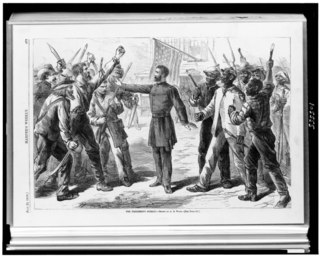
The Bureau of Refugees, Freedmen, and Abandoned Lands, usually referred to as simply the Freedmen's Bureau, was an agency of early Reconstruction, assisting freedmen in the South. It was established on March 3, 1865, and operated briefly as a U.S. government agency, from 1865 to 1872, after the American Civil War, to direct "provisions, clothing, and fuel...for the immediate and temporary shelter and supply of destitute and suffering refugees and freedmen and their wives and children".
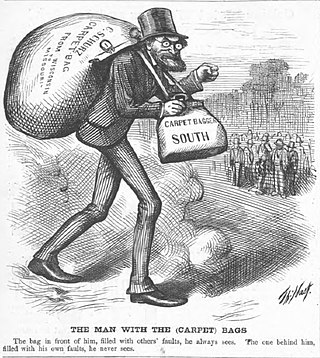
In the history of the United States, carpetbagger is a largely historical term used by Southerners to describe opportunistic Northerners who came to the Southern states after the American Civil War, who were perceived to be exploiting the local populace for their own financial, political, and/or social gain. The term broadly included both individuals who sought to promote Republican politics and individuals who saw business and political opportunities because of the chaotic state of the local economies following the war. In practice, the term carpetbagger was often applied to any Northerners who were present in the South during the Reconstruction Era (1865–1877). The term is closely associated with "scalawag", a similarly pejorative word used to describe native white Southerners who supported the Republican Party-led Reconstruction.

A mammy is a U.S. historical stereotype depicting black women who work in a white family and nurse the family's children. The fictionalized mammy character is often visualized as a fat, dark-skinned woman with a motherly personality. The origin of the mammy figure stereotype is rooted in the history of slavery in the United States, as black slave women were often tasked with domestic and childcare work in white American slaveholding households. The mammy caricature was used to create a narrative of black women being happy within slavery or within a role of servitude. The mammy stereotype associates black women with domestic roles and it has been argued that it, combined with segregation and discrimination, limited job opportunities for black women during the Jim Crow era, approximately 1877 to 1966.

Beloved is a 1987 novel by American novelist Toni Morrison. Set in the period after the American Civil War, the novel tells the story of a dysfunctional family of formerly enslaved people whose Cincinnati home is haunted by a malevolent spirit. The narrative of Beloved derives from the life of Margaret Garner, an enslaved person in the slave state of Kentucky who escaped and fled to the free state of Ohio in 1856.
The Redeemers were a political coalition in the Southern United States during the Reconstruction Era that followed the Civil War. Redeemers were the Southern wing of the Democratic Party. They sought to regain their political power and enforce white supremacy. Their policy of Redemption was intended to oust the Radical Republicans, a coalition of freedmen, "carpetbaggers", and "scalawags". They generally were led by the White yeomanry and they dominated Southern politics in most areas from the 1870s to 1910.
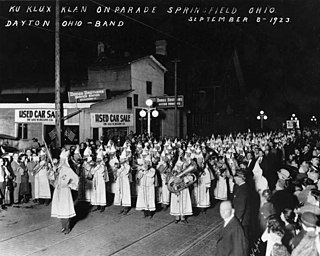
The nadir of American race relations was the period in African-American history and the history of the United States from the end of Reconstruction in 1877 through the early 20th century, when racism in the country, especially anti-black racism, was more open and pronounced than it had ever been during any other period in the nation's history. During this period, African Americans lost access to many of the civil rights which they had gained during Reconstruction. Anti-black violence, lynchings, segregation, legalized racial discrimination, and expressions of white supremacy all increased. Asian Americans were also not spared from such sentiments.
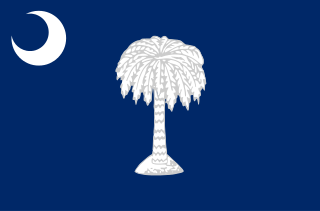
South Carolina was the first state to secede from the Union in December 1860, and was one of the founding member states of the Confederacy in February 1861. The bombardment of the beleaguered U.S. garrison at Fort Sumter in Charleston Harbor on April 12, 1861 is generally recognized as the first military engagement of the war. The retaking of Charleston in February 1865, and raising the flag again at Fort Sumter, was used for the Union symbol of victory.
A masquerade ceremony is a cultural or religious event involving the wearing of masks. In the Dogon religion, the traditional beliefs of the Dogon people of Mali, there are several mask dances, some of which include the Sigi festival. The Sigi entered the Guinness Book of Records as the "Longest religious ceremony."
The Jim Crow laws were state and local laws introduced in the Southern United States in the late 19th and early 20th centuries that enforced racial segregation, "Jim Crow" being a pejorative term for an African-American. Such laws remained in force until the 1960s. Formal and informal segregation policies were present in other areas of the United States as well, even if several states outside the South had banned discrimination in public accommodations and voting. Southern laws were enacted by white Southern Democrat-dominated state legislatures to disenfranchise and remove political and economic gains made by African Americans during the Reconstruction era.
The civil rights movement (1865–1896) aimed to eliminate racial discrimination against African Americans, improve their educational and employment opportunities, and establish their electoral power, just after the abolition of slavery in the United States. The period from 1865 to 1895 saw a tremendous change in the fortunes of the black community following the elimination of slavery in the South.
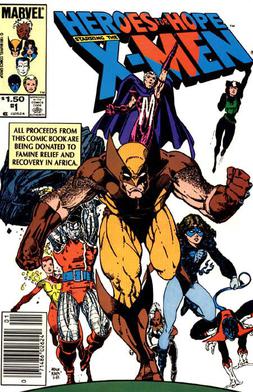
Heroes for Hope: Starring the X-Men is a 1985 Marvel comic book designed to raise awareness about hunger in Africa. Proceeds from the comic went to the American Friends Service Committee, to assist in their work on behalf of African famine relief and recovery. Published in the form of a "comic jam" or exquisite corpse, the book featured an all-star lineup of comics creators as well as a few notable authors from outside the comic book industry, such as Stephen King, George R. R. Martin, and Edward Bryant. It also saw a rare Alan Moore Marvel Comics credit outside his early Marvel UK work.

A Visit from the Old Mistress is an 1876 painting by the prominent 19th-century American artist Winslow Homer. It was one of several works that Homer is thought to have created during a mid-1870s visit to Virginia, where he had served for a time as a Union war correspondent during the Civil War. Scholars have noted that the painting's composition is taken from Homer's earlier painting Prisoners from the Front, which depicts a group of captive Confederate soldiers defiantly regarding a Union officer. Put on display in the northern states for a northern audience, A Visit from the Old Mistress, along with Homer's other paintings of black southern life from the postbellum period, has been praised as an "invaluable record of an important segment of life in Virginia during the Reconstruction."
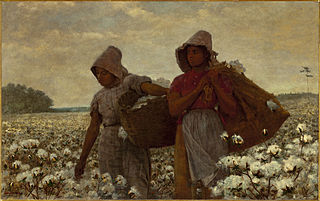
The Cotton Pickers is an 1876 oil painting by Winslow Homer. It depicts two young African-American women in a cotton field.
Stately, silent and with barely a flicker of sadness on their faces, the two black women in the painting are unmistakable in their disillusionment: they picked cotton before the war and they are still picking cotton afterward.
The Ocoee massacre was a mass racial violence event that saw a white mob attack numerous African-American residents in the northern parts of Ocoee, Florida, a town located in Orange County near Orlando. The massacre took place on November 2, 1920, the day of the U.S. presidential election.

Black South Carolinians are residents of the state of South Carolina who are of African ancestry. This article examines South Carolina's history with an emphasis on the lives, status, and contributions of African Americans. Enslaved Africans first arrived in the region in 1526, and the institution of slavery remained until the end of the Civil War in 1865. Until slavery's abolition, the free black population of South Carolina never exceeded 2%. Beginning during the Reconstruction Era, African Americans were elected to political offices in large numbers, leading to South Carolina's first majority-black government. Toward the end of the 1870s however, the Democratic Party regained power and passed laws aimed at disenfranchising African Americans, including the denial of the right to vote. Between the 1870s and 1960s, African Americans and whites lived segregated lives; people of color and whites were not allowed to attend the same schools or share public facilities. African Americans were treated as second-class citizens leading to the civil rights movement in the 1960s. In modern America, African Americans constitute 22% of the state's legislature, and in 2014, the state's first African American U.S. Senator since Reconstruction, Tim Scott, was elected. In 2015, the Confederate flag was removed from the South Carolina Statehouse after the Charleston church shooting.















